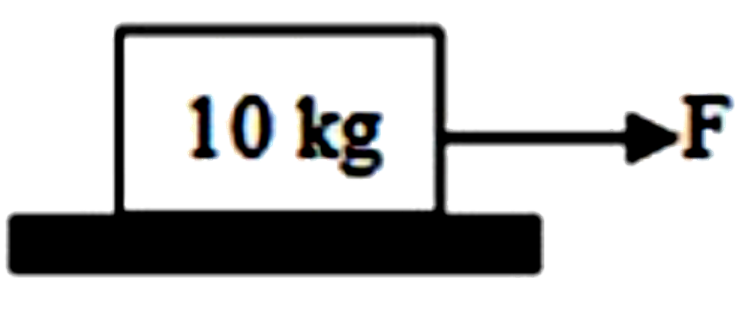A ship of mass 3×102kg initially at rest is pulled by a force of 5×104 N through a distance of 3m. Neglecting frcition, the speed of the ship at this moment is:
31.62m/s
1.55m/s
0.15m/s
2m/s
The correct Answer is:C
To solve the problem, we will use the work-energy theorem, which states that the work done on an object is equal to the change in its kinetic energy. Here are the steps to find the speed of the ship:
Step 1: Identify the known values
- Mass of the ship, m=3×102kg=300kg
- Force applied, F=5×104N
- Distance moved, d=3m
- Initial speed, u=0m/s (the ship is initially at rest)
Step 2: Calculate the work done by the force
The work done W by the force can be calculated using the formula:
W=F×d
Substituting the known values:
W=(5×104N)×(3m)=1.5×105J
Step 3: Apply the work-energy theorem
According to the work-energy theorem:
W=ΔKE=KEfinal−KEinitial
Since the ship starts from rest, the initial kinetic energy KEinitial=0:
W=KEfinal−0=KEfinal
Thus, we have:
1.5×105J=KEfinal
Step 4: Express kinetic energy in terms of speed
The kinetic energy KE is given by the formula:
KE=12mv2
Substituting for KEfinal:
1.5×105J=12(300kg)v2
Step 5: Solve for v2
Rearranging the equation to solve for v2:
1.5×105=150v2
Dividing both sides by 150:
v2=1.5×105150=1000
Step 6: Calculate the final speed v
Taking the square root of both sides:
v=√1000≈31.62m/s
Final Answer
The speed of the ship at this moment is approximately 31.62m/s.
---
- Mass of the ship, m=3×102kg=300kg
- Force applied, F=5×104N
- Distance moved, d=3m
- Initial speed, u=0m/s (the ship is initially at rest)
The work done W by the force can be calculated using the formula:
W=F×d
Substituting the known values:
W=(5×104N)×(3m)=1.5×105J
According to the work-energy theorem:
W=ΔKE=KEfinal−KEinitial
Since the ship starts from rest, the initial kinetic energy KEinitial=0:
W=KEfinal−0=KEfinal
Thus, we have:
1.5×105J=KEfinal
The kinetic energy KE is given by the formula:
KE=12mv2
Substituting for KEfinal:
1.5×105J=12(300kg)v2
Rearranging the equation to solve for v2:
1.5×105=150v2
Dividing both sides by 150:
v2=1.5×105150=1000
Taking the square root of both sides:
v=√1000≈31.62m/s
The speed of the ship at this moment is approximately 31.62m/s.
Topper's Solved these Questions
- NEWTONS LAWS OF MOTIONBook:ALLENChapter:NEWTONS LAWS OF MOTIONExercise:EXERCISE-III
Explore 28 Videos
- NEWTONS LAWS OF MOTIONBook:ALLENChapter:NEWTONS LAWS OF MOTIONExercise:EXERCISE-I
Explore 52 Videos
- NEWTON'S LAWS OF MOTION & FRICTIONBook:ALLENChapter:NEWTON'S LAWS OF MOTION & FRICTIONExercise:EXERCISE (JA)
Explore 4 Videos
- RACEBook:ALLENChapter:RACEExercise:Basic Maths (Wave Motion & Dopplers Effect) (Stationary waves & doppler effect, beats)
Explore 24 Videos
Similar Questions
If a ship of mass 4×107 kg initially at rest is pulled by a force of 5×104 N through a distance of 4 m, then the speed of the ship will be (resistance due to water is negligible )
View SolutionA ship of mass 3×107kg initially at rest, is pulled by a force of 5×105N through a distance of 3m. Assuming that the resistance due to water is negligible, the speed of the ship is
View Solution
Knowledge Check
A ship of mass 3×107 kg initially at rest is pulled by a force of 5×104N through a distance of 3 m. Assume that the resistance due to water is nigligible, the speed of the ship is
A1.5 m/sB60 m/sC0.1 m/sD5 m/sA ship of mass 3×107 kg initially at rest is pulled by a force of 5×104 N through a distance of 3 m. Assuming that the resistance due to water is neglible, what will be the speed of ship ?
A1.5 m/secB60 m/secC0.1 m/secD5m/sec
80 railway wagons all of same mass 5×103kg are pulled by an engine with a force of 4×105N. The tension in the coupling between 30 th and st 31st wagon from the engine is :-
View SolutionAn engine of mass5×104 kg pulls a coach of mass 4×104kg. Suppose that there is a resistance of 1 N per 100 kg acting on both coach and engine, and that the driving force is 4500N. The acceleration of the engine and the coupling will respectively be
View SolutionA body of mass 5×103kg moving with speed 2 m/s collides with a body of mass 15×103kg inelastically & sticks to it. Then loss in K.E. of the system will be :
View SolutionA force F=2t2 is applied to the cart of mass 10 Kg, initially at rest. The speed of the cart at t = 5 s is -

View SolutionA force of 10 N acts on a body of mass 2 kg for 3s , initially at rest. Calculate change in momentum of the body.
View SolutionA neutron of mass 1.67×10−27 kg moving with a speed of 3×106ms−1 collides with a deutron of mass 3.34×10−27 kg which is at rest. After collision, the neutron sticks to the deutron and forms a triton. What is the speed of the triton?
View Solution

